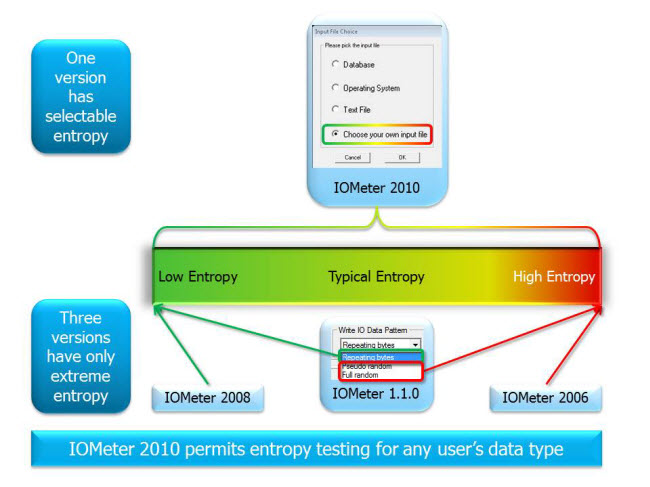Part two of this Write Amplification (WA) series covered how WA works in solid-state drives (SSDs) that use data reduction technology. I mentioned that, with one of these SSDs, the WA can be less than one, which can greatly improve flash memory performance and endurance.
Why is it important to know your SSD write amplification?
Well, its not really necessary to know the write amplification of your SSD at any particular point in time, but you do want an SSD with the lowest WA available. The reason is that the limited number of program/erase cycles that NAND flash can support keeps dropping with each generation of flash developed. A low WA will ensure the flash memory lasts longer than flash on an SSD with a higher WA.
A direct benefit of a WA below one is that the amount of dynamic over provisioning is higher, which generally provides higher performance. In the case of over provisioning, more is better, since a key attribute of SSD is performance. Keep in mind that, beyond selecting the best controller, you cannot control the WA of an SSD.
Just how smart are the SSD SMART attributes?
The monitoring system SMART (Self-Monitoring, Analysis and Reporting Technology) tracks various indicators of hard disk solid state drive reliability — including the number of errors corrected, bytes written, and power-on hours — to help anticipate failures, enabling users to replace storage before a failure causes data loss or system outages.
Some of these indicators, or attributes, point to the status of the drive health and others provide statistical information. While all manufacturers use many of these attributes in the same or a similar way, there is no standard definition for each attribute, so the meaning of any attribute can vary from one manufacturer to another. Whats more, there’s no requirement for drive manufacturers to list their SMART attributes.
How to measure missing attributes by extrapolation
Most SSDs provide some list of SMART attributes, but WA typically is excluded. However, with the right tests, you can sometimes extrapolate, with some accuracy, the WA value. We know that under normal conditions, an SSD will have a WA very close to 1:1 when writing data sequentially.
For an SSD with data reduction technology, you must write data with 100% entropy to ensure you identify the correct attributes, then rerun the tests with an entropy that matches your typical data workload to get a true WA calculation. SSDs without data reduction technology do not benefit from entropy, so the level of entropy used on them does not matter.

IOMeter provides multiple entropy types, but only IOMeter 2010 permits user selectable entropy for simulating real-world data environments.
To measure missing attributes by extrapolation, start by performing a secure erase of the SSD, and then use a program to read all the current SMART attribute values. Some programs do not accurately display the true meaning of an attribute simply because the attribute itself contains no description. For you to know what each attribute represents, the program reading the attribute has to be pre-programmed by the manufacturer. The problem is that some programs mislabel some attributes. Therefore, you need to perform tests to confirm the attributes true meaning.
Start writing sequential data to the SSD, noting how much data is being written. Some programs will indicate exactly how much data the SSD has written, while others will reveal only the average data per second over a given period. Either way, the number of bytes written to the SSD will be clear. You want to write about 10 or more times the physical capacity of the SSD. This step is often completed with IOMeter, VDbench, or other programs that can send large measurable quantities of data.
At the end of the test period, print out the SMART attributes again and look for all attributes that have a different value than at the start of the test. Record the attribute number and the difference between the two test runs. You are trying to find one that represents a change of about 10, or the number of times you wrote to the entire capacity of the SSD. The attribute you are trying to find may represent the number of complete program/erase cycles, which would match your count almost exactly. You might also find an attribute that is counting the number of gigabytes (GBs) of data written from the host. To match that attribute, take the number of times you wrote to the entire SSD and multiply by the physical capacity of the flash. Technically, you already know how much you wrote from the host, but it is good to have the drive confirm that value.
Doing the math
When you find candidates that might be a match (you might have multiple attributes), secure erase the drive again, this time writing randomly with 4K transfers. Again, write about 10 times the physical capacity of the drive, then record the SMART attributes and calculate the difference from the last recording of the same attributes that changed between the first two recordings. This time, the change you see in the data written from the host should be nearly the same as with the sequential run. However, the attribute that represents the program/erase cycles (if present) will be many times higher than during the sequential run.
To calculate write amplification, use this equation:
( Number of erase cycles x Physical capacity in GB ) / Amount of data written from the host in GB
With sequential transfers, this number should be very close to 1. With random transfers, the number will be much higher depending on the SSD controller. Different SSDs will have different random WA values.
If you have an SSD with the type of data reduction technology used in Seagate’s SandForce controller, you will see lower and lower write amplification as you approach your lowest data entropy when you test with any entropy lower than 100%. With this method, you should be able to measure the write amplification of any SSD as long as it has erase cycles and host data-written attributes or something that closely represents them.
Protect your SSD against degraded performance
The key point to remember is that write amplification is the enemy of flash memory performance and endurance, and therefore the users of SSDs. This three-part series examined all the elements that affect WA, including the implications and advantages of a data reduction technology like the SandForce DuraWrite technology. Once you understand how WA works and how to measure it, you will be better armed to defend yourself against this beastly cause of degraded SSD performance.
This three-part series examines some of the details behind write amplification, a key property of all NAND flash-based SSDs that is often misunderstood in the industry.
Part 1: Why SSDs hate amplification
Part 2: When does an amplifier make things smaller?








Leave A Comment